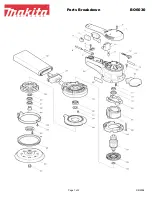
9
Original instructions
EN
Area of application
Regulator
position
1. Sanding plaster coated surfaces
with sandpaper
E - G
2. Sanding wood and removing lacquer
and dye coatings
D - G
3. Sanding metal with sandpaper
E - G
4. Rough cleaning, metal or
stone sanding
G
The sander is equipped with full-wave tacho-
constant electronics for:
- Soft start and restriction of the starting cur-
rent;
- Speed pre-selection and adjustment and
maintaining constant rpm upon overloading;
- Overload protection:
A current clutch actuates upon considerable
brief overload to switch the machine off until the
load drops down.
Upon minor continuous overload the thermal
overload protection actuates, to reduce mo-
tor rpm. The machine becomes disabled. To
resume operation after the machine has cooled
down for 2-4 minutes, first turn off and then turn
on the ON/OFF switch;
- Non-self starting safety (NVR) at restoring
the mains supply. To resume operation after
the current clutch has switched the machine off,
release the ON/OFF switch and then press the
switch again.
- Stabilizing the spindle speed.
MOUNTING THE ACCESSORIES
When mounting the sanding accessories fix the
sander spindle (1) by pressing the lock button
(3) positioned on the gear box.
WARNING:
Never press the button
(3) while the spindle (8) is still rotating!
SANDING WITH SANDPAPER
The selection of sandpaper depends on the de-
sired surface quality. For rough operations use
sandpaper with larger grit size, and for fine and
finishing operations use sandpaper with smaller
grit size to achieve surface smoothness.
We recommend using original SPARKY acces-
sories specially designed for achieving optimum
results.
Use only hook-and-loop sanding sheets.
Do not use sanding discs with diameter exceed-
ing the maximum permitted for the power tool.
Refer to power tool specifications.
MOUNTING THE ACCESSORIES fOR
SANDING WITH SANDPAPER
The precise and accurate performance of the
below described procedures guarantees the
reliable and safe operation with the power tool.
All instructions are important and result from our
huge experience gained during design and op-
eration of power tools for the described use.
1. Ensure that the power tool is unplugged.
2. Turn the machine in a way ensuring ac
-
cess to the operating tool. We recommend fixing
the machine in stationary position. Thus it would
be possible to use both hands for convenient
and safe assembly.
3. Clean the threaded and face surfaces of
the spindle (8) using soft cloth and brush.
4. Take out the sanding set from the pack-
ing.
5. Clean the flange (14) face surface and
arbour and the support disc (27) face surfaces
using a soft cloth and brush. The support flange
(14) is the thinner flange.
6. Place the support flange (14) onto the
spindle (8) observing the orientation - its flat
face should stick to the spindle (8) flange. In
-
correctly chosen flange (14) will deteriorate dust
extraction.
7. Ensure there is no dirt or foreign body be-
tween the spindle (8) face and the flange (14)
face which may hamper their contact. The pres-
ence of foreign bodies and disturbed face con-
tact are prerequisites for inexact movement of
the operating tool and increased vibration caus-
ing unsatisfactory quality of the processed sur-
face.
8. Mount the support disc (15) on the flange
(14) and ensure there are no foreign bodies be-
tween their faces.
9. Fasten the tightening nut (16) to fix the
support disc (15) to the spindle (8) firmly. It is
obligatory to observe the tightening nut (16) ori-
entation as shown on Fig. A. Otherwise tighten
-
ing the support disc (15) will not be possible.
10. Press the spindle lock button (3) and ro-
tate the support disc (15) clockwise until the but-
ton sinks and locks the spindle (8) movement.
11. Fasten the tightening nut (16) reliably us
-
ing the pin spanner (26) supplied with the ma
-
chine.
12. Release the spindle lock button (3) and
ensure that the button is back in its initial po-
sition and does not lock the spindle (8) move
-
ment. If necessary rotate the spindle (8) by hand
to release the button (3) so it can return in its
initial position.
Та
ше
в
-
Га
лв
ин
г
ОО
Д
www.tashev-galving.com












































